Mszana Dolna
Borough of Mszana Dolna, Limanowski District, Małopolski VoivodshipType of place
Jewish cemetery in Mszana Dolna, a private property.Information about the crime
Abraham Borgerg (born 1912 in Zambrzyce) was one of the Jews from Nowy Sącz region who survived the Holocaust. From his account recorded in 1969 we learn about the living conditions in Mszana Dolna during the war: „After the displacement from the neighboring towns, such as Dobra and Rabka, many Jews came to Mszana, even from Kraków and Nowy Targ. There were also women displaced from Łódź. There were about 1,000 Jews in Mszana Dolna at that time. […] There was an open ghetto in Mszana, it was only prohibited to walk in some streets. All young people were employed in various jobs in the quarries and on the roads. They were harassed, etc. Even 8-year-old children were forced to work.” (301/1692 The Jewish Historical Institute, Archives of Accounts)
- In September 1939 the Wehrmacht troops killed 20 people brought from Rabka. The execution took place in Zarabie, next to the Raba river. At first, the victims were buried at night by the perpetrators at the place of execution. Then the bodies were exhumed by the local Jews and buried in the Jewish cemetery in Mszana Dolna. The questionnaire about executions and mass graves from 1945 states that the victims were buried in one grave measuring 8x6m.
- In the autumn 1940, 300 Jews were killed in a mass execution. The bodies were buried in a mass grave behind the buildings of the State Agricultural Farm in Mszana Dolna. The witness of this event, Walenty R.: „In the autumn of 1940, the Polish youth dug a big pit. Then 300 Jews were brought there. This is how the execution proceeded. A footbridge was led through the pit, on which the Jews were walking one by one, and from the opposite side they were shot with the machine guns. Both the death and the wounded fell or jumped into the pit. Each layer was poured with lime. The grave was covered after one week, till this time the grave was moving, because some of them were still alive. (IPN BU 2448/455 p. 156)
- Probably at the turn of April and May 1942 in Mszana Dolna, gestapo officers from Nowy Sącz shot between 18 and 24 people. The reason was allegedly failing to register for road works. The bodies were buried in one grave measuring 8×2,5m on the fields called „Aderówka”, behind the C. Warhanek factory. (IPN Gk 163/9) We know the following names:
Moses Aron Turner, aged 40, a butcher and merchant from Mszana Dolna,
Moritz Stamberger, aged 43, a butcher from Mszana Dolna
Wanda Gutter, aged 18, displaced from Kraków to Mszana Dolna
Schlachet (the first name unknown), aged 45, a tradesman from Dobra/Limanowa
Mania Ginsberg
This event is also described by Abraham Borger: „The first action in Mszana Dolna was on April 20, 1942, on Hitler’s birthday. The action was carried out in various towns, in Nowy Sącz and Limanowa. In Mszana Dolna, 10 people, including young girls and boys, were put up against the wall. A boy named Chaim Landau and two others managed to escape from there. After three days they were captured by the Germans. One of them was almost buried alive. It was a 16-year-old boy named Weber, a son of a rabbi. His own father was forced to bury him, because he was among those who dug graves. The boy shouted: „Tate, ich Lejb!”. He was only shot in his leg.” (301/1692 The Jewish Historical Institute, Archives of Accounts)
- From July to August 1942, shootings were carried out in the yard of the Borough Office building. About 20 people died this way. We know the following names:
Jankiel Turner, aged 30, from Mszana Dolna,
10 people from the Zessler family (men, women and young girls),
Members of the Langsman family (women) and Sessler family,
Felicja Herz, aged 35, from Mszana Dolna,
Two young girls named Hochmann aged 5-12,
A man named Weczer.
The bodies were taken to the Jewish cemetery in Mszana Dolna and buried there. The graves varied in size, they were dug on an ongoing basis, containing from 2 to 10 bodies. (IPN Gk 163/9)
- The largest execution of Mszana Dolna residents took place on August 19, 1942, and the displaced people there. About 900 people were murdered that day, including old people, women and children. The aim of this action was to kill all the Jews in Mszana Dolna. The bodies were buried in the manor fields, in two graves with dimensions of approx. 22X10m. There were approx. 500 victims in one grave, and approx. 400 victims in another one. The following description of that day can be found in the execution card drawn up in 1971: „Gestapo from Nowy Sącz came to Mszana Dolna, where the Jewish population gathered in the market square on the order of the mayor, Gelb. They ordered the Jewish people to lie face down on the ground, and they led them in the groups to the execution site located nearby. They were shot there. Children, women and old people were murdered also. 900 people were murdered this way.” (IPN BU 2448/453 p. 13)
Abraham Borger’s parents, Róża and Lipman Borgers, as well as his only brother Bernard died in this execution. „The general liquidation action took place in 1942. On August 19, they gathered all Jews on the market square. Out of all these people, about one hundred were selected to work, and 10 people to clean up the things that belonged to the murdered people, as it turned out later. I was among these ten. The rest were shot and buried in Mszana Dolna. 881 people were shot. After the war we built a memorial on that grave, to commemorate these people. […] Just 10 Jews were left out of the entire population. We were cleaning up the things of the murdered. This was my fate, that the things of my parents and my brother, who also died there – I had to have them in my hands.” (301/1692 The Jewish Historical Institute, Archives of Accounts)
A shocking description of the murder of the Jewish population in Mszana Dolna can be found in the document with the reference number IPN Gk 195/VII/8 written by Józef Bieniek, a regionalist and historian of the Nowy Sącz region. (attached in the references – it can be downloaded at the bottom of the page)
Commemoration
On August 21, 2022 – August 22, 2022, the commemoration of the 80th anniversary of the liquidation of the local Jewish community took place in Mszana Dolna. Part of the celebrations was a ceremony commemorating the victims buried in mass graves at the local Jewish cemetery. The ceremonies were also held at the renovated monument to the Victims of Mass Execution in Pańskie. During the ceremony, a matzeva/monument was unveiled along with the names of the victims that could be determined. The celebrations were attended by the relatives of the Mszana Jewish community murdered during the Holocaust. The celebration was the culmination of many years of work by the Shtetl Mszana Dolna Foundation to commemorate the Jewish community of Mszana Dolna.
The place of the grave was marked with a wooden matzevah in 2020 as part of the project “Reference points – marking 24 Jewish war graves with wooden matzevot ”. The project is an attempt to find a way of marking these places before they can be commemorated. Marking forgotten Jewish war graves with wooden matzevot is a subtle intervention in the landscape reminding about what remains invisible, yet present in the memory of local communities. Being only a temporary commemoration, wooden matzevot invite local communities to discuss and take action, to discover the places, and perhaps to start their own memory practice related to them or to initiate a permanent commemoration.
You can read more about the project here: https://tinyurl.com/2p9ar52f
The project was implemented thanks to the funding from The Association of the Jewish Historical Institute of Poland (Stowarzyszenie Żydowski Instytut Historyczny) and The Matzevah Foundation.
IDENTIFICATION OF THE GRAVE BASED ON NON INVASIVE RESEARCH
On March 28, 2019 a site inspection was carried out at the Jewish cemetery (N 49°39.893′ E 020°03.871′) in order to determine the location of the mass graves.
As a result of archival aerial query, a picture of this area was obtained (TUGX913 frame 395/1942 or 1944). The aerial photography shows the area of the Jewish cemetery and the dirt road running along the northern border. A ground disturbance is visible clearly from the west and slightly less visible from the north. Aerial photography query for this area is still ongoing in order to obtain better quality photos.
The LiDAR survey shows ground disturbances in the western and northern parts of the cemetery.
In May 2022, tests were carried out using the MALA X3M georadar (500 Mhz).
14 georadar profiles were made in two axes (length/width). Profiles named MSD0001 – MSD0007 and MSD0009 – MSD0015. Penetration depth approx. 3.00 m /60 ns (p.p.t.).
The results of the collected GPR data confirm numerous ground disturbances ranging from 1.00 m – 1.50 m (ppt) depth (purple color on GPR profiles). The area subjected to the tests is a rectangle with an approximate format of 8 m by 9 m. This area is entirely a collection of many anomalies, the origin of which can be related with high probability to the existence of mass graves in this area. In addition, it should be remembered that the very nature of the location (ravine) and the roots of growing trees also affect the results of GPR surveys.
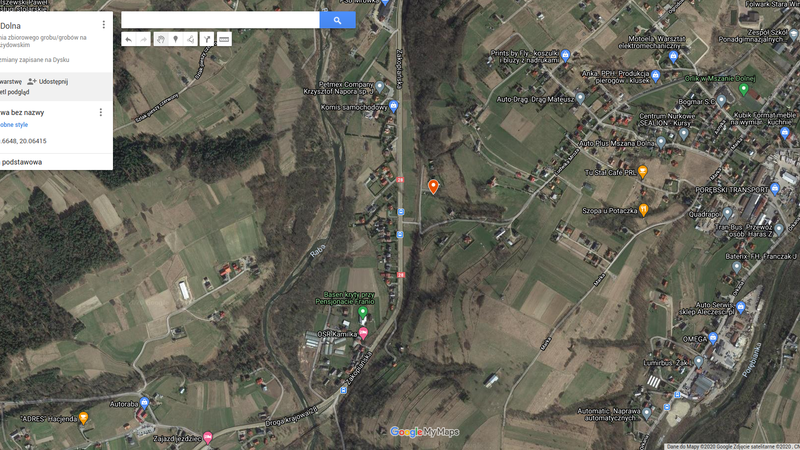 fotografia lokalizacji 1a Mszana Dolna
fotografia lokalizacji 1a Mszana Dolna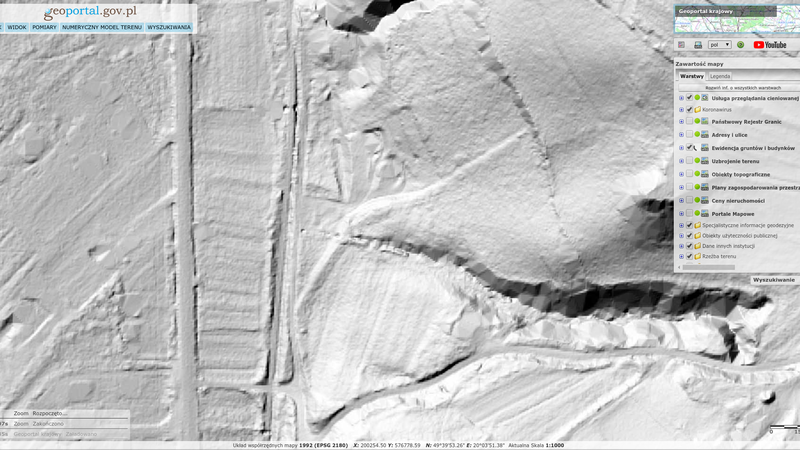 LiDAR 1 Mszana Dolna
LiDAR 1 Mszana Dolna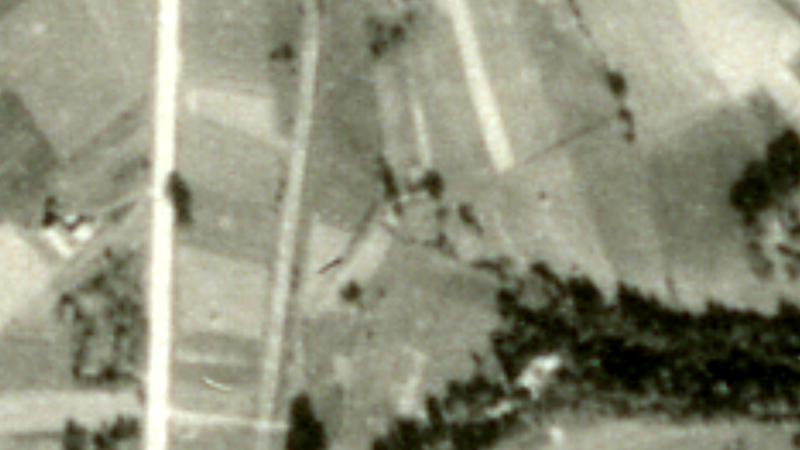 fotografia lotnicza 1a Mszana Dolna
fotografia lotnicza 1a Mszana Dolna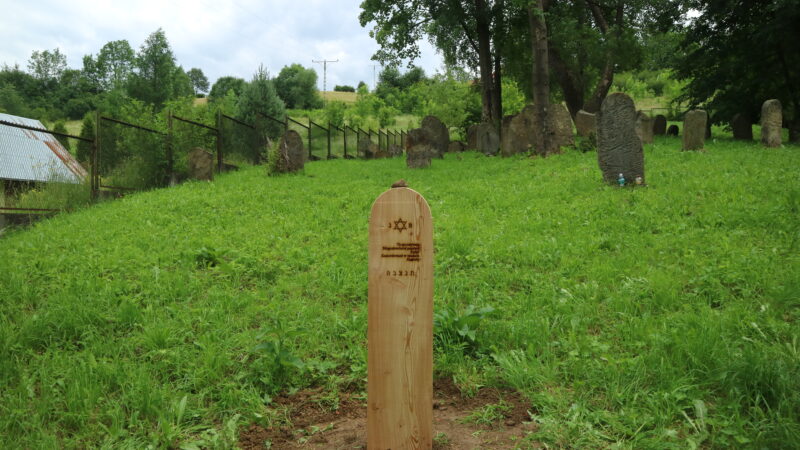 fotografia 1 lokalizacji Mszana Dolna
fotografia 1 lokalizacji Mszana Dolna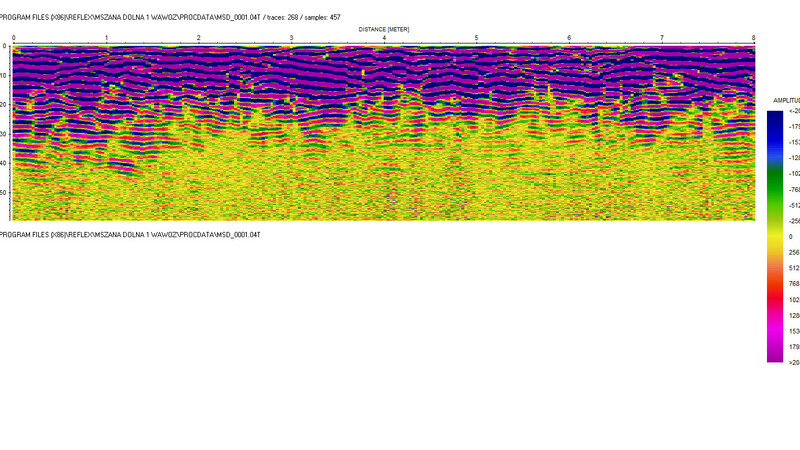 Mszana Dolna 0001
Mszana Dolna 0001Sources
Contact and cooperation
We are still looking for information on the identity of the victims and the location of Jewish graves in Mszana Dolna. If you know something more, write to us at the following address: fundacjazapomniane@gmail.com.
Bibliography
GK 196/477, The trial of Józef Buhler; The shooting of 900 Jews on August 19, 1942 in Mszana Dolna – files of the Petty Offence Court in Mszana Dolna, 1947-1948 [CD-ROM].
IPN Kr 1/11585, List of Jews from Mszana Dolna made by the Judenrat in Mszana Dolna on September 15, 1942 [CD-ROM].
IPN Kr 1/8878 (IPNKr-12-1-1-42), IPN Kr 1/8879 (IPNKr – 12-1-1-43), IPN Kr 1/8880 (IPNKr-12-1-1-44) , IPN Kr 1/8881 (IPNKr-12-1-1-45) (The Regional Commission for the Examination of Crimes against the Polish Nation in Krakow, Monuments – graves of murdered Jews in Mszana Dolna, photos).
IPN Kr 502/4156, files of the case against Szczepan Czas.
GK 163/9, Survey. Executions. Graves. Krakowskie voivodeship; volume II; Questionnaires about mass executions and mass graves – krakowskie voivodeship, 1939-1945
IPN BU 2448/455, GK surveys. Limanowa district, krakowskie voivodeship.
IPN BU 2448/453, regarding Jewish graves in Mszana Dolna, questionnaire “Executions”.
IPN 195 / VII / 8, regarding Jewish war graves in Mszana Dolna, Limanowa district (e.g. Scout Alert).
The account of Abraham Borger 301/1692 AŻIH


 IPN Bu 2448/455 Ankiety GK. Mszana Dolna
IPN Bu 2448/455 Ankiety GK. Mszana Dolna